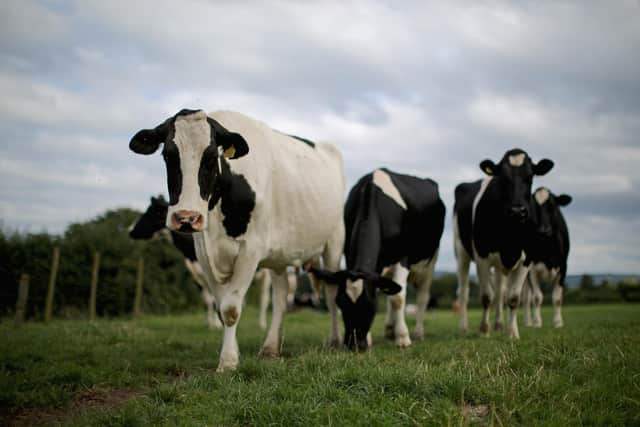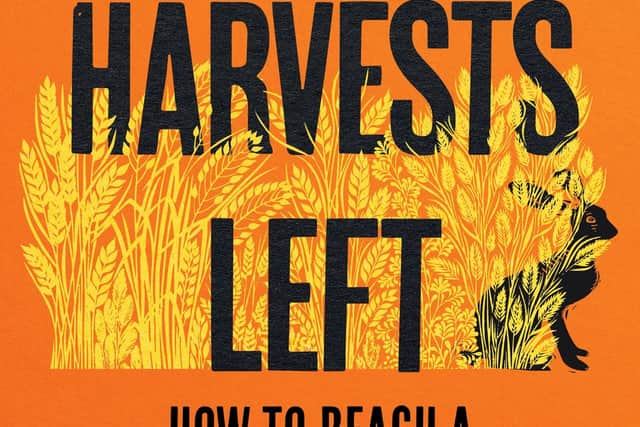Sixty Harvests Left: How living on a farm helped teach me about the extraordinary value of soil – Philip Lymbery
Where I’ve lived for the past five years, distant hills fringe the skyline. The nearby river rises out of chalk and clay before weaving through our valley along tree-lined banks of oak, hazel and willow. If I wait patiently on an ancient stone bridge, I often catch a glimpse of a dazzling blue kingfisher. Nearby, badgers make their setts in sandy soil, while roe deer hide in the thickets and copses.
Daily, I walk the fields and woods around our farm hamlet with rescue dog Duke, a large, black crossbreed reminiscent of a baby bear. He came to us as a ten-week-old puppy, having been abandoned. I love his company and he loves our walks together.
Advertisement
Hide AdAdvertisement
Hide AdLiving here, I see the good and the bad of farming first-hand. I see how farmland wildlife has changed: once-common skylarks have all but disappeared. Native grey partridges are now rare among the many red-legged partridges introduced for the local shoot.
Roads choked with soil
I also see soils on the move; I see maize, a common animal-feed crop, planted in tramlines down local hillsides, encouraging soil to run towards the river. And when soil goes into the river, so too do chemical fertilisers and pesticides, causing pollution.
After heavy rain, the local roads can get choked with soil. Things got so bad that the residents of one hamlet nearby woke up one morning to find that part of a field had slid into their garden, potatoes and all!
That said, there is still much to celebrate in the countryside, including the return of the red kite and the buzzard, two magnificent bird species that were once all but eradicated. I can still find orchids in the pasture and at the edges of woodlands. Most years, bramblings and woodlarks visit. Tiny harvest mice live among the lupins near a picturesque old church. But for how much longer?


There is no escaping the sense that society in general seems to live as if in an endless summer, with lifestyles based on short-term thinking and a belief that things will just last forever. Come what may.
But that summertime of consumption without limits feels like it is now starting to end. We are perhaps beginning to recognise the consequences of living beyond our planetary boundaries. The climate crisis and the collapse of nature have a feeling of a looming autumn, while Covid has given us a collective taste of winter.
Through my walks with Duke in the local countryside together, with decades spent exploring the realities of farming worldwide, I’ve discovered that, if we are to enjoy a new spring, the way we do things in the countryside has to change.
Sixty Harvests Left


How we reach this new spring has been the impetus behind some of my most recent writing, culminating in the book, Sixty Harvests Left: How to Reach a Nature-Friendly Future. Its title came from a chilling warning made by the United Nations that the world’s soils could be gone within just 60 years. No soil, no food. A frightening prospect.
Advertisement
Hide AdAdvertisement
Hide AdIt was a warning that I could scarcely believe to be true. Which is why I embarked on a journey to discover where it had come from, what the evidence-base was, and what could be done about it. I travelled the country and worldwide looking at farming practices. I distilled my findings into that book.
I discovered that a major culprit for the decline of soils, wildlife and the welfare of animals is industrial agriculture. It’s a way of farming that has sprung up since the middle of the last century, where animals are reared in confinement, while crops are grown in huge, prairie-like fields of a single variety using chemical pesticides and artificial fertilisers. It comes at a heavy cost to our health, the environment and animal welfare.
Turning things around is fast becoming one of the biggest and most pressing challenges of our time.
Cows want to enjoy life
Restoring our countryside and its soil means moving away from industrial agriculture. A handful of healthy soil harbours more living organisms than the number of people on the planet. Bringing back this richness would not only preserve our ability to grow food in the future but could also lead to more nutritious food for today.
One of the keys to this better way can be found on the world’s pastures where, rather than rearing them industrially in feedlots and confinement, cattle and other farmed animals are able to graze naturally. Compared to pasture-raised beef or free-range chicken, the industrially reared equivalent has as much as twice the saturated fat and is lower in other nutrients.
I see this from our window; my neighbour’s 40 cows graze the valley of the river Rother that meanders past home. Here, the rich grassland is infused with spiny tussocks of thigh-high soft rush. The cows cross the river at will, gathering at favoured shallows before wading together in a line. Their antics remind me anew of how they are sentient creatures, very much aware of their world and, like the rest of us, keen to enjoy their lives.
My sense of the connectedness of food, animals and nature has been brought home by living on a farm. Through living in the countryside, I’ve found that the secret to how well we might live in the future lies in the true value we place on the soil beneath our feet and the life within it.
Philip Lymbery is chief executive of Compassion in World Farming, a former United Nations Food Systems Champion and author of Farmageddon: The True Cost of Cheap Meat and Dead Zone: Where the Wild Things Were. He will be speaking about his new book Sixty Harvests Left: How to Reach a Nature-Friendly Future at Toppings in Edinburgh on February 9. He is on Twitter @philip_ciwf
Comments
Want to join the conversation? Please or to comment on this article.
